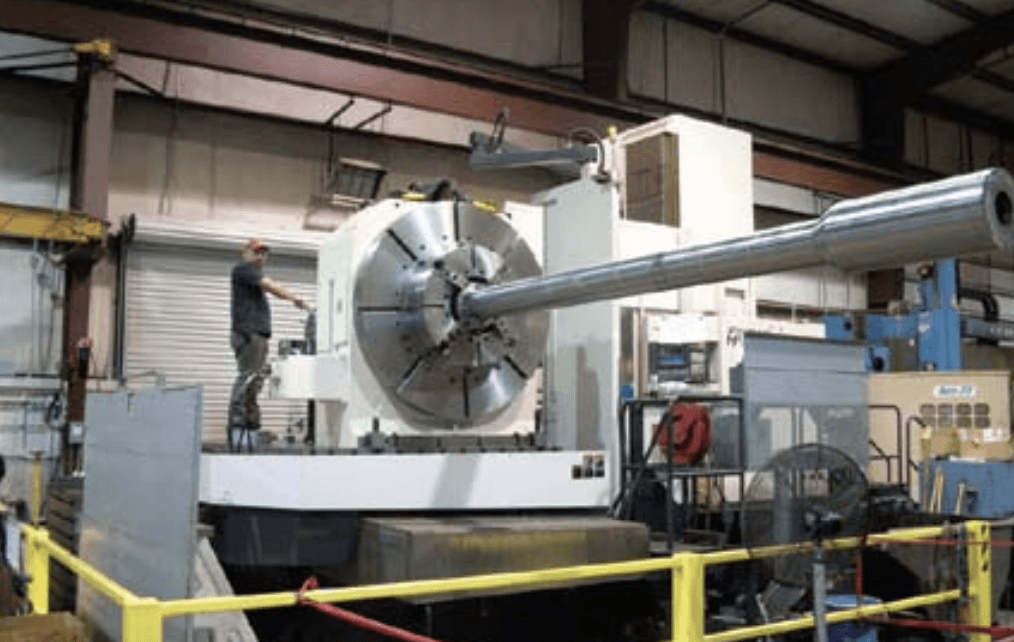Rotary Table Handles Big Oil Field Parts

Workpieces for the oil field can take many shapes and sizes. Parts that are long, heavy, and awkward to handle for turning, milling, and then finish turning are not uncommon. RTI Energy Systems (Spring, TX) a subsidiary of RTI International Metals, was able to expand its machining capabilities by acquiring a Tsudakoma RNCV1501 1.5-m NC rotary table from Koma Precision Inc. (East Windsor, CT) to handle a deepwater component that was 20′ (6-m) long and weighed 6000 lb (2721 kg).
RTI Energy Systems specializes in oil and gas systems engineering and manufacturing services, producing deepwater and ultra-deepwater riser systems and other specialized equipment for production, export, completion, and workover operations used in the search and recovery of hydrocarbon reserves globally. The primary part the rotary table was purchased for is a flanged, alloy-steel stress joint for deepwater riser systems. “Without the rotary table, we wouldn’t have been able to handle a workpiece of this size and stay within the strict tolerances required to produce a quality part while maintaining efficiency,” explains Steven K. Hensley, manufacturing engineer, RTI Energy. “The workpiece is an oil-production piece that starts out as a 6000-lb [2721-kg] steel alloy forging that is first turned on one of its two large lathes, and then fixtured in the rotary table for milling on a Toshiba BTH-130.R24 horizontal boring and milling machine.”
Customization of the rotary table was done by Flanagan Industries, which custom-milled the center bore to meet the specifications provided by RTI. The main reason for the custom bore-through rotary table is to handle large parts of that size and weight and be able to index and maintain greater than 0.5° tolerance and the correct orientation of the workpiece to the milling machine. The majority of the parts that RTI is looking at machining with the rotary table have features that are clocked around the OD or related features on different planes and are long, heavy large-diameter parts.
The workpiece posed a challenge because of a number of special features. “The workpiece has several pockets, slots, and tapped holes of various sizes, and an intersecting hole in the face of the part. The rotary table had to meet the precision requirements of these features and maintain repeatability for multiple part production runs,” says Hensley. “These features are oriented to two rows of 16 holes—16 tapped and 16 thread-milled holes—in each row along the OD of the part that are clocked at 22.5° increments with a tolerance of ±0.5°. There is also an API ring groove on a milled flat behind the hub of the OD that is oriented to these OD features and has an intersecting hole from the face of the part,” says Hensley.
The Tsudakoma RNCV1501 features an NC controller package and has the ability of the through hole to be modified to accommodate the intended part. The rotary table can be vertically mounted without the need of a support structure, or horizontally mounted for other applications. The rotary table is equipped with a Pratt Burned chuck and a Schmidt Tool steadyrest. The chuck is a 32″ (813-mm) diameter independent four-jaw chuck with a 16″ (406-mm) diameter through bore and custom adapter plate for mounting to the table. The Schmidt mill steadyrest is a RIP-144 model that has a range from 4.6 to 24″ (117–610-mm) diameter with a 25,000 lbs. (11,340-kg) capacity. The table itself weighs in at about 17,000 lb (7711 kg) and is mounted on the milling machine table which has a maximum capacity of 44,000 lbs. (19,958 kg).
Future plans for the rotary table include full integration of the control system with the Toshiba NC control to allow more efficient off-line programming. This will also give RTI the ability to use the rotary as a programmable axis, which would add the ability of contouring more complex components.
An added benefit of having the Tsudakoma rotary with the NC controller package is the flexibility to use the rotary table on any larger mills that RTI may purchase in the future.
Other services and capabilities of RTI Energy Systems include procurement of raw materials, NDE (Non-Destructive Examination) such as AUT (Automated Ultrasonic Testing) and MT (Magnetic Particle Testing). RTI also specializes in welding, cladding and fabrication of valves, fittings, wellheads, trees, pipes, specialty joints, and other components. RTI has large part machining capabilities that range from a 65′ (19.8 m) and 21′ (6 m) in length CNC lathes that can swing 40″ (1016-mm) diam parts to a CNC VTL (vertical turning lathe) that has a 90″ (2286-mm) diam chuck and 33,000-lb (14,968-kg) capacity. The company also has several other medium slant-bed CNC lathes and manual lathes.